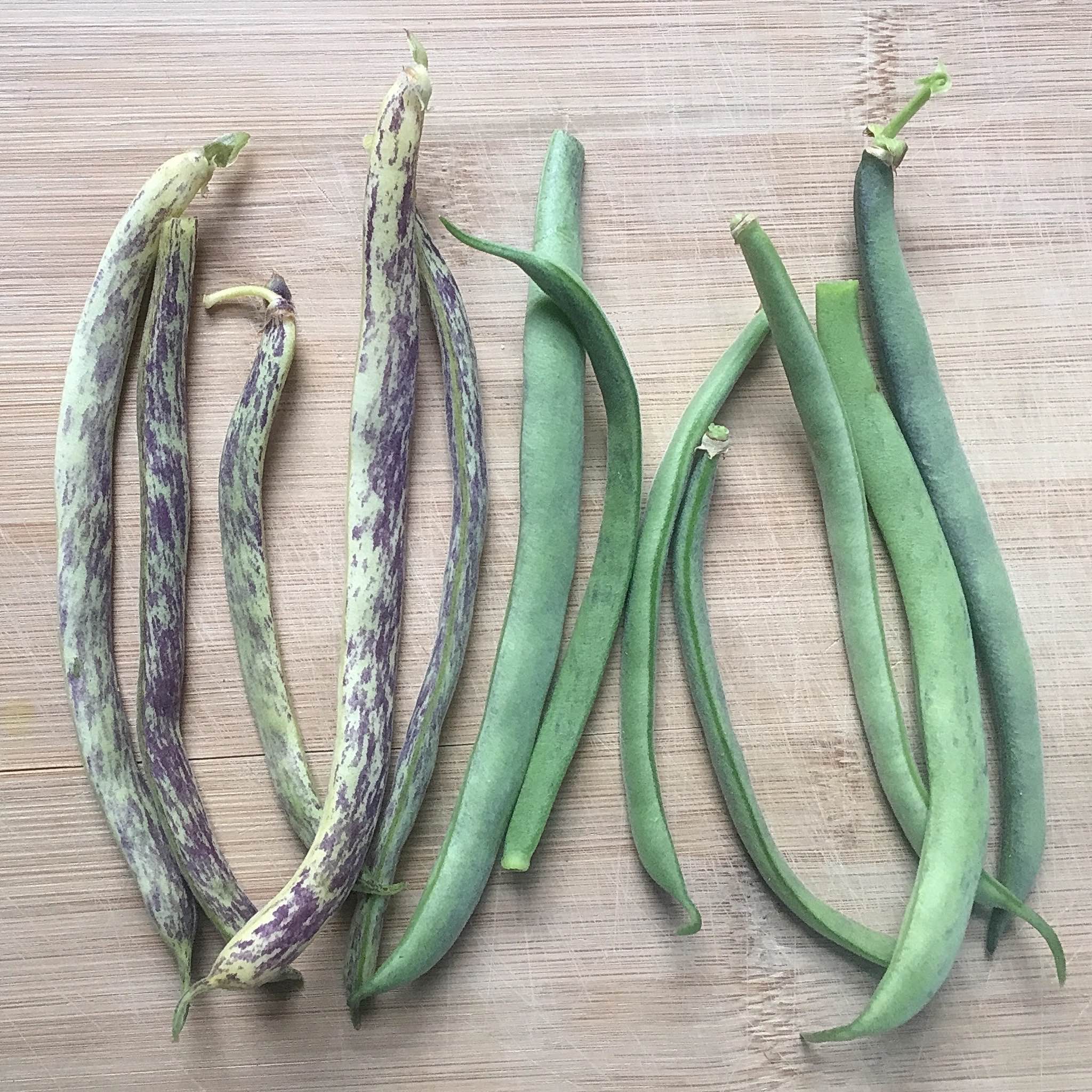Zeedman
Garden Master
Well, my brief period of temporary seasonal employment has ended, so I can get caught up on the remaining 2023 bean results.
In a year with a lot of disappointments, there were also some surprising successes. One of my ongoing projects is a search for day-neutral varieties of historically daylength-sensitive tropical vegetables. Hyacinth beans are one of those, so I trial new varieties as I can. This year I trialed 3 varieties - and to my astonishment, all 3 proved to be day neutral!
The first was "Khyati", a bush variety from Seeds of India. Much like the other bush variety I've grown previously, it flowered very quickly - about 30 days from planting, before any of the other beans had flowered. The plants were exceptionally vigorous, branched heavily, and continued to blossom all summer even when heavily laden with pods. Those pods were tiny (1 - 1.5") but borne in huge numbers. This variety is apparently bred for green-shelled or dry use, but the beans are tiny, the size of small green peas. The shellies I tested (which were a PITA to shell) even tasted much like peas when cooked. There were no problems with insects or diseases, and even the mice left them alone until late in the season.
To be honest, I was a bit discouraged by the tiny pods; and after the initial trial & some seed saving, I just let them go. The seed below is no more than 10% of the total - the stout plants fell over under the weight of the continually-developing pod set. I'd like to find a more efficient way to process the seeds & learn more about their usage, because despite the small seed size, the yield is impressively large. I think the seed count per plant actually rivals or surpasses most pole beans.
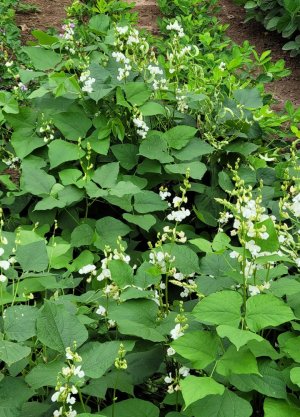
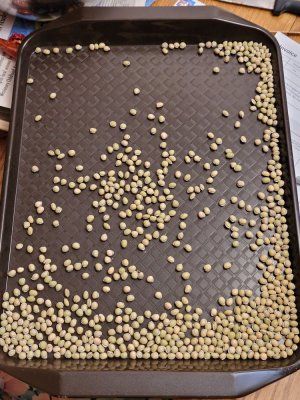
"Khyati", in bloom, and the 4 ounces of dry seed collected. The photos below are of the single plant pulled for testing as shellies, with all leaves removed to show the pods:
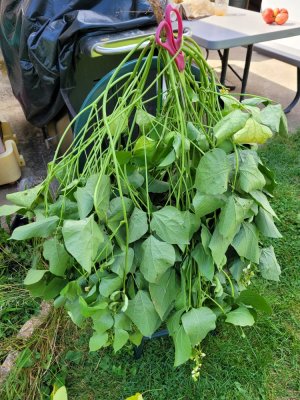
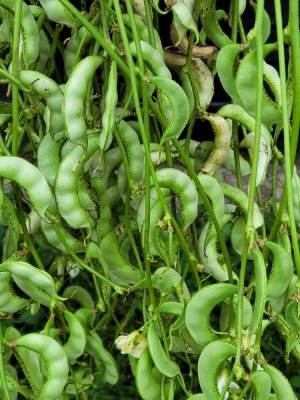
The other two hyacinth bean trials were "Early Meaty" and "Early #1", both from Asian Garden 2 Table in Florida (who post an awesome collection of Asian vegetable tutorials on y-tube). Both were purple-flowered pole varieties, planted side-by-side because given that all pole varieties I've tried previously were photo-period sensitive, I just wanted to see if seed production was possible. Much to my surprise, both bloomed in July, quickly set pods, and actually produced dry seed before some of my pole beans. I don't have a lot of photos, because that part of the garden was overcome by weeds until late in the season. If you look carefully, you can just see a few vines & purple flowers behind the white-flowered volunteer litchi tomato... and in my one attempt to photograph the flowers, the camera focused on the ground for some reason. At least it shows the beautiful flower color.
At least it shows the beautiful flower color.
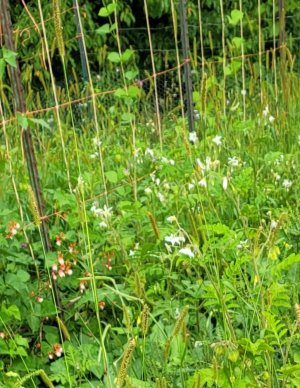
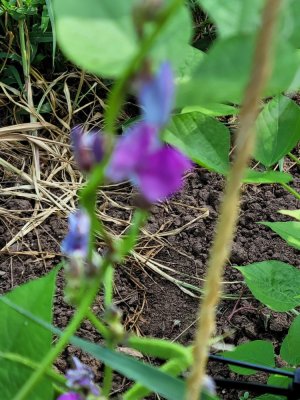
Both varieties were obviously pole, but stunted into near-bush habit by the severe weed pressure. Both had nearly identical flowers & seeds; but the pods were very different. One had immature pods that were flat & snow pea-like (pictured below), while the other had fatter, fleshier pods. I plan to regrow both varieties for seed & culinary trials next year, hopefully under conditions which allow them to show their true potential. The black seeds below are of both varieties
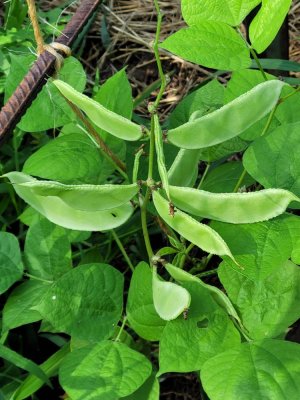
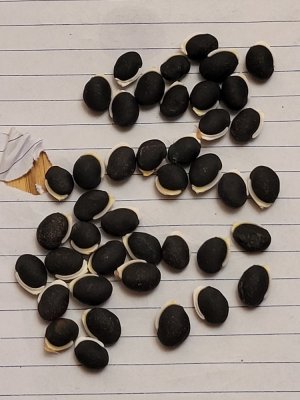
In a year with a lot of disappointments, there were also some surprising successes. One of my ongoing projects is a search for day-neutral varieties of historically daylength-sensitive tropical vegetables. Hyacinth beans are one of those, so I trial new varieties as I can. This year I trialed 3 varieties - and to my astonishment, all 3 proved to be day neutral!

The first was "Khyati", a bush variety from Seeds of India. Much like the other bush variety I've grown previously, it flowered very quickly - about 30 days from planting, before any of the other beans had flowered. The plants were exceptionally vigorous, branched heavily, and continued to blossom all summer even when heavily laden with pods. Those pods were tiny (1 - 1.5") but borne in huge numbers. This variety is apparently bred for green-shelled or dry use, but the beans are tiny, the size of small green peas. The shellies I tested (which were a PITA to shell) even tasted much like peas when cooked. There were no problems with insects or diseases, and even the mice left them alone until late in the season.
To be honest, I was a bit discouraged by the tiny pods; and after the initial trial & some seed saving, I just let them go. The seed below is no more than 10% of the total - the stout plants fell over under the weight of the continually-developing pod set. I'd like to find a more efficient way to process the seeds & learn more about their usage, because despite the small seed size, the yield is impressively large. I think the seed count per plant actually rivals or surpasses most pole beans.


"Khyati", in bloom, and the 4 ounces of dry seed collected. The photos below are of the single plant pulled for testing as shellies, with all leaves removed to show the pods:


The other two hyacinth bean trials were "Early Meaty" and "Early #1", both from Asian Garden 2 Table in Florida (who post an awesome collection of Asian vegetable tutorials on y-tube). Both were purple-flowered pole varieties, planted side-by-side because given that all pole varieties I've tried previously were photo-period sensitive, I just wanted to see if seed production was possible. Much to my surprise, both bloomed in July, quickly set pods, and actually produced dry seed before some of my pole beans. I don't have a lot of photos, because that part of the garden was overcome by weeds until late in the season. If you look carefully, you can just see a few vines & purple flowers behind the white-flowered volunteer litchi tomato... and in my one attempt to photograph the flowers, the camera focused on the ground for some reason.


Both varieties were obviously pole, but stunted into near-bush habit by the severe weed pressure. Both had nearly identical flowers & seeds; but the pods were very different. One had immature pods that were flat & snow pea-like (pictured below), while the other had fatter, fleshier pods. I plan to regrow both varieties for seed & culinary trials next year, hopefully under conditions which allow them to show their true potential. The black seeds below are of both varieties



